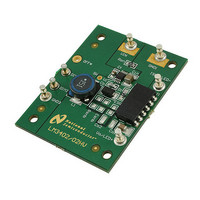LM3402HVEVAL National Semiconductor, LM3402HVEVAL Datasheet

LM3402HVEVAL
Specifications of LM3402HVEVAL
Related parts for LM3402HVEVAL
LM3402HVEVAL Summary of contents
Page 1
... LED array. Fig- ure 1 shows the pinout of J1. Solid gauge wire with about insulation stripped away makes a convenient, solderless connection to J1. © 2007 National Semiconductor Corporation National Semiconductor Application Note 1500 Chris Richardson June 2007 ...
Page 2
The logic of DIM1 is direct, hence the LM3402/02HV will de- liver regulated output current when the voltage at DIM1 is high, and the current output is disabled when the voltage at DIM1 is low. Connecting a constant logic low ...
Page 3
ID Part Number U1 LM3402 L1 SLF10145T-101M1R0 D1 CMSH1-60M Cf VJ0805Y104KXXAT Cb VJ0805Y103KXXAT Cin C3216X7R1H105M Rsns ERJ6BQFR56V Ron CRCW08054642F Rz CRCW08050R00F DIM1, DIM2 160-1512 GND1, GND2, 160-1026 GND3, VIN, ISNS / 535676-5 FIGURE 3. ...
Page 4
ID Part Number U1 LM3402HV L1 SLF10145T-151MR79 D1 CMSH1-100M Cf VJ0805Y104KXXAT Cb VJ0805Y103KXXAT Cin C3225X7R2A105M Co1 C3216X7R1E225M Rsns ERJ6BQFR68V Ron CRCW08051303F Rz CRCW08050R00F DIM1, DIM2 160-1512 GND1, GND2, 160-1026 GND3, VIN, ISNS / 535676-5 ...
Page 5
Typical Performance Characteristics Efficiency for Table 25° 350 for Table 25°C A DIM Pin Enable Table 1 Efficiency for Table 25°C, ...
Page 6
Switching Waveforms for Table 1 DIM Pin Enable Table 2 Switching Waveforms for Table 2 www.national.com Output Ripple Current Table 1 20198014 DIM Pin Disable Table 2 20198016 Output Ripple Current Table 2 20198018 6 20198015 20198017 20198019 ...
Page 7
Layout Top Layer and Top Overlay 7 20198006 www.national.com ...
Page 8
Bottom Layer and Bottom Overlay 8 20198007 ...
Page 9
Notes 9 www.national.com ...
Page 10
... National Semiconductor and the National Semiconductor logo are registered trademarks of National Semiconductor Corporation. All other brand or product names may be trademarks or registered trademarks of their respective holders. ...










